What the Lemosho Route 8 Days tour is really like and what you can expect - my day-day account.
But first, why did I choose the Lemosho Route 8 Day Tour?
I choose it for a few reasons.
- First, it's widely considered to be the most beautiful route of all the seven routes.
- It's also one of the longer routes allowing for better acclimatization, resulting in a high summit success rate to reach the roof of Africa.
- Plus, as there's less distance to cover each day, there's time to hike at a slow pace, further increasing your chances of reaching the summit.
- The 8-day Lemosho Route goes up the western side of the mountain and offers an ideal balance of low crowds, compared to other routes like the the most popular, the Machame route, which goes up the southern slopes.
Faster hikers may find going so Pole, Pole (slowly, slowly) a bit frustrating, especially at the lower elevations but you want to enjoy your Kilimanjaro trek and avoid altitude sickness as long as possible.
And with the Lemosho Route 8 Day tour, you'll get beautiful scenery as your climb to the highest point on the continent of Africa.
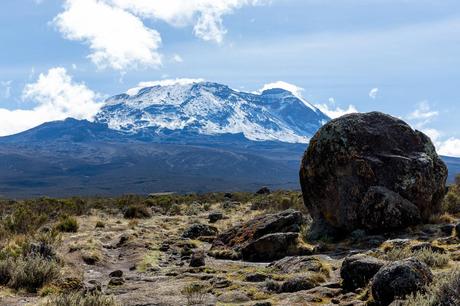
Faster hikers may find going so Pole, Pole (slowly, slowly) a bit frustrating, especially at the lower elevations but you want to enjoy your Kilimanjaro trek and avoid altitude sickness as long as possible.
And with the Lemosho Route 8 Day tour, you'll get beautiful scenery as your climb to the highest point on the continent of Africa.
Day 1: Drive to Kilimanjaro National Park & Trek From Lemosho Gate to Forest Camp
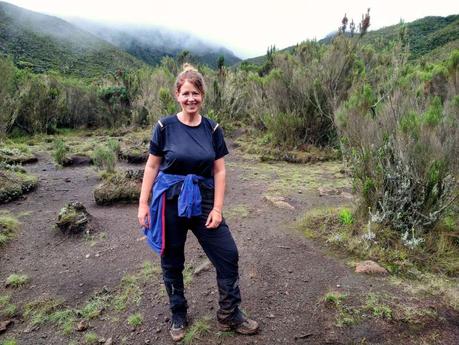
For our first day, we drive to the starting point for the Lemosho trailhead and hike to Forest Camp, also called Mti Mkubwa camp or Big Tree Camp .
It's an easy day hiking through rain forest. I'm excited to spot the gorgeous black and white colobus monkeys, even if they're in the distance. The hiking is easy at this lower elevation and it's a short day.
Blue monkeys (which are actually olive in color) soon make an appearance at the Forest Camp, where we spend the night. They're experts at stealing food. I'm much more entertained than the chef is.
It's supposed to be a 3 hour hike, but our group consists of fast hikers and it only took us about 2 1/2 hours.
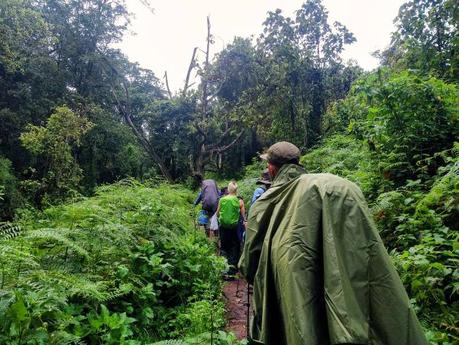
It rained for a good part of the hike, as to be expected in a rainforest, and especially if you hike Kili in November.
Walking Distance: 3.7 mi/6.0 km
Walking Time: 3-4 Hours
Elevation Gain: 1,700 ft/518 m
Day 2: Hike From Forest Camp to Shira Camp I

We leave the rainforest from the Forest Camp and step into heather and moorland. It's a steep climb in places but despite the estimated 6-7 hours, we arrive at Shira 1 Camp in under 5 hours.
The highest elevation we reached today was 12,697 ft (3870 m), but the camp is at elevation of 11,483 feet (~3500 m). I don't feel any signs of altitude sickness yet.
It was another easy day. I feel good, despite all the rain again today, which is why I don't have so many photos from today.
Shira Camp 1 is also very open, so there's no protection from the wind or rain, but fortunately it's not that windy.
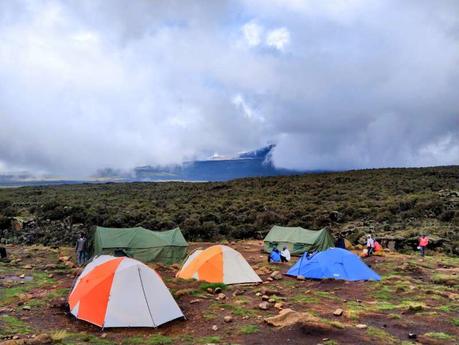
I'm in awe of the fact that despite leaving after us to dissemble our tents, the porters have passed us, already arrived and have almost finished setting up our tents. They are to be celebrated!
Day 3: Shira l Camp to Moir Hut Camp
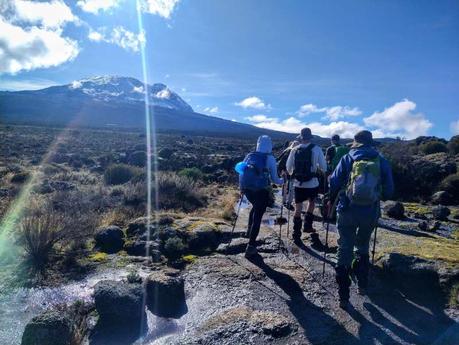
Today we leave Shira Camp and head across the Shira Plateau and Shira Ridge towards Shira 2 Camp and then onwards to Moir Hut Camp, a little used camp site, a bit off the main trail that we had all to ourselves.
We start with a small creek crossing that requires a big jump across, but fortunately everyone made it without getting wet.
We spend most of the day on the Shira Plateau and get our first glimpse of the east peak of glacier-covered Kili - not the side we'll be climbing, but it's so motivating to see where we're going.
We walk through moorland meadows until we reach Moir Hut Camp in 4.5 hours later including breaks and a stop at the rock garden and a photo opp where we all climbed up a large boulder with Kili in the background.
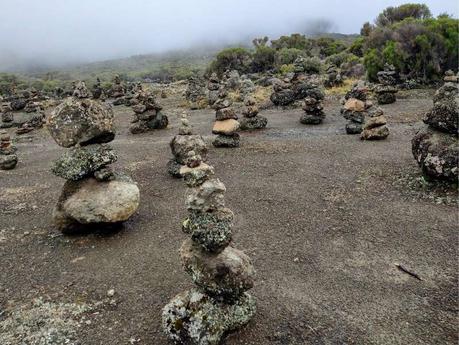
The hike today was 8.7 mi/14.0 km with 2,300 ft/701 m of elevation gain. Moir Hut Camp is at 4140 m/13579 ft. I started feeling the elevation at ~3600m. Not bad, just a slight headache and slightly shorter shortness of breath.
After so much hiking in the rain, I was so grateful for the sun and to see Kili. It was a great day!
Day 4: Moir Hut Camp to Lava Tower to Barranco Hut Camp
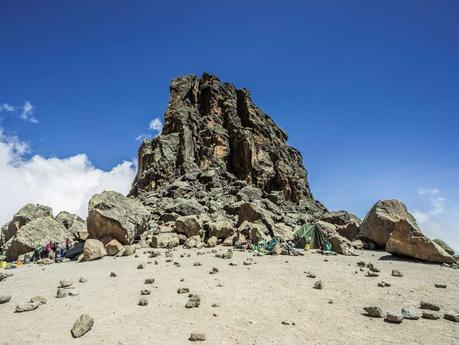
Today we leave Moira Hut Camp and heads towards the Lava Tower, the highest point on the tour at 15,000 ft (4572 m) before we reach Barafu Base Camp.
On the way up, I start feeling the altitude. I have a slight headache, but really start to notice a shortness of breath. Still, nothing too bad.
The plan was to have lunch at Lava Tower to give us time to acclimatize at this altitude, but that didn't happen, given the rain and cold temperature. I've included photos of it on the day I was there vs on a sunny day, so you can see the difference.
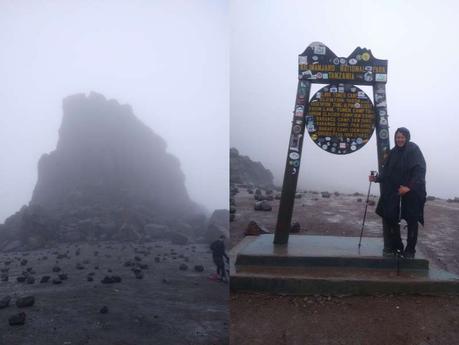
It poured most of the day, as you can see from the photos.
The descent down from Lava Tower to the Barranco Valley was treacherous and slippery, with little streams popping up everywhere due to all the rain.
The highlight was seeing the Giant Groundsel trees

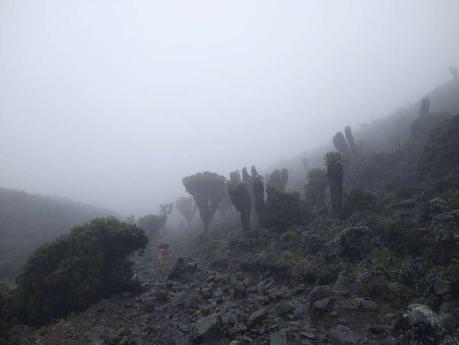
I'm told that normally the path is beautiful but we couldn't see more than a few meters ahead of us.
I've attached a photo of how it was when I was there and how it looks on a clear day, which may also help explain my grumpiness.
I arrive at Barranco Camp totally soaked, despite wearing a poncho. I'm not the only one. This was the low point in morale for our group, with a few tense discussions.
Fortunately, once we vented our frustration and grumpiness, we bonded, and I look back on that day in the tent now with fondness.
It's all part of the Kili experience - and a test to see how you react when you're not feeling your best.
Also, fortunate is that my mild altitude sickness has disappeared now that I've descended to an elevation of 12,795 feet (3900 m).
Today's distance was 4.4 mi/7.0 km. The estimated hiking time was 5-6 hours, but we did it under 4.5 hours.
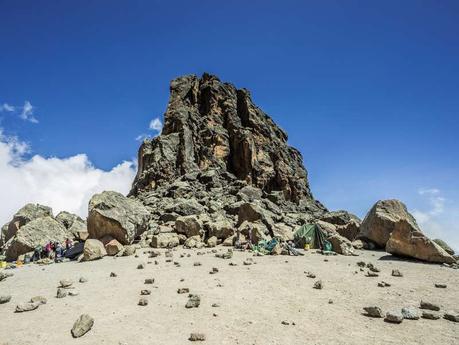
Today we leave Moira Hut Camp and heads towards the Lava Tower, the highest point on the tour at 15,000 ft (4572 m) before we reach Barafu Base Camp.
On the way up, I start feeling the altitude. I have a slight headache, but really start to notice a shortness of breath. Still, nothing too bad.
The plan was to have lunch at Lava Tower to give us time to acclimatize at this altitude, but that didn't happen, given the rain and cold temperature. I've included photos of it on the day I was there vs on a sunny day, so you can see the difference.
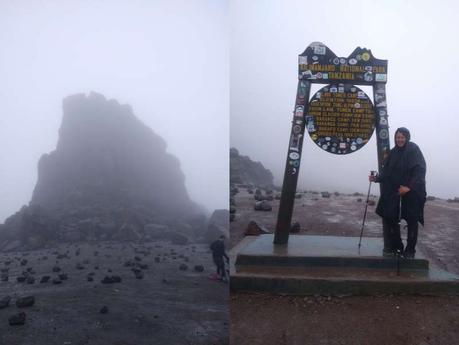
It poured most of the day, as you can see from the photos.
The descent down from Lava Tower to the Barranco Valley was treacherous and slippery, with little streams popping up everywhere due to all the rain.
The highlight was seeing the Giant Groundsel trees

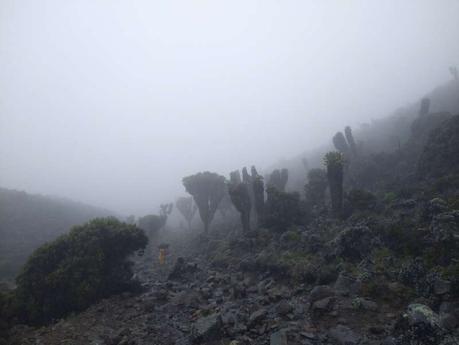
I'm told that normally the path is beautiful but we couldn't see more than a few meters ahead of us.
I've attached a photo of how it was when I was there and how it looks on a clear day, which may also help explain my grumpiness.
I arrive at Barranco Camp totally soaked, despite wearing a poncho. I'm not the only one. This was the low point in morale for our group, with a few tense discussions.
Fortunately, once we vented our frustration and grumpiness, we bonded, and I look back on that day in the tent now with fondness.
It's all part of the Kili experience - and a test to see how you react when you're not feeling your best.
Also, fortunate is that my mild altitude sickness has disappeared now that I've descended to an elevation of 12,795 feet (3900 m).
Today's distance was 4.4 mi/7.0 km. The estimated hiking time was 5-6 hours, but we did it under 4.5 hours.
Walking Distance: 4.4 mi/7.0 km
Walking Time: 5-6 Hours
Elevation Loss: 800 ft/244 m
Day 5: Barranco Hut Camp to Karanga Camp
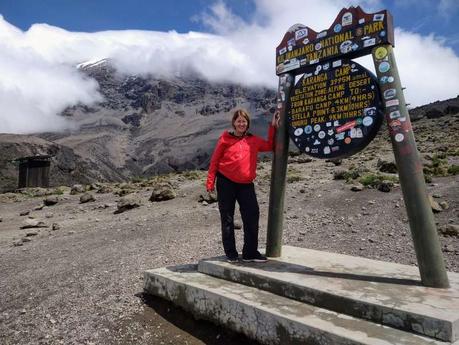
Today we leave Barranco Hut Camp (3900m / 12,795 ft) heading towards to Karanga Camp (4040m / 13259 ft).
We quickly reach the Barranco Wall, a wall with narrow sections requiring a bit of scrambling (using your rocks up pull yourself up in places). I'm in awe of watching the porters carrying heavy loads on tiny little ledges and doing it with ease.
After yesterday's discussions, we agreed to start earlier today to try and avoid some of the rain, so we start at 6:40 am.
We were moderately successful. It still rained, but not as much and we also had blue skies as we headed into the Karanga Valley. Was a mixed bag as you can see from the photos.
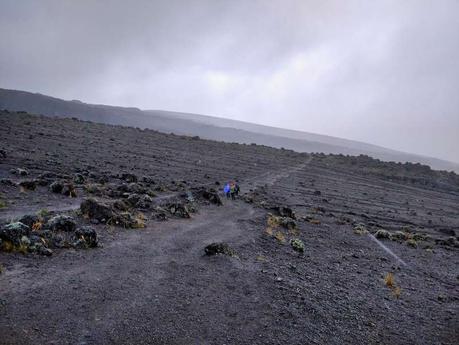
Tonight at camp is the first night our guide starts monitoring our heart and oxygen rate. My oxygen was higher than expected and my heart rate was lower than expected - both good signs of a successful summit in 2 days.
I feel good, my signs of altitude sickness from yesterday have dissipated now that we've descended and my spirits are high. It's also very motivating when you can see Kili and see where you're headed.
The estimated hiking time was 4-5 hours, but we did it under 3.5 hours.
Day 6: Karanga Camp to Barafu Camp

It's getting real, we leave Karanga Camp heading towards Barafu Camp, or Base Camp (4673m / 15331 ft). It's our last camp before we make the final approach to the summit of Kili.
Anticipation is high and we FINALLY have good weather.

We have lunch, then as we're getting ready to do an acclimatization hike when I feel my backpack is all wet - my new water bladder has leaked. It's beyond repair.

A fellow hiker kindly lends me his, but now my down jacket is soaked. I tie it to my tent and hope it will dry before the summit push.
We hike up ~200 m higher, to acclimizate on the same route that we'll take on our final climb to Kili. It's to help us get used to the high altitude and also to see what the terrain is like in daylight. We'll repeat this section starting at midnight and won't be able to see much. ,Each step feels like a struggle, but we hike slowly, Pole, Pole.
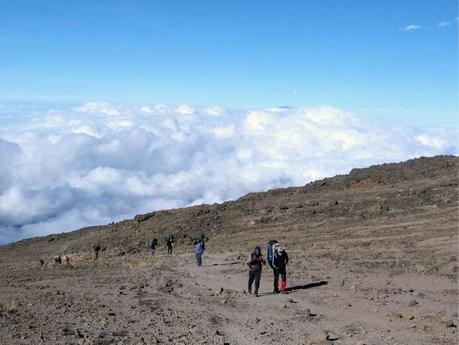
We return back to to Barafu Camp where we have the rest of the day to relax and enjoy the views of the summit and Kibo's glaciered peak.
It's magical being at this altitude, above the clouds. Winds change the landscape from one minute to the next. Kili keeps disappearing and reappearing from the clouds.
I feel the altitude. I have a slight headache and a shortness of breath and am a bit dizzy. Still, nothing too bad. What I notice most is that my breath holds keep getting shorter and shorter as I ascent. From one minute at an elevation of 200m, to 15 seconds at this altitude.
Our guide David measures our oxygen and heart rate again. My oxygen has decreased and my heart rate is high - but still in a safe range.
I try and rest, mostly unsuccessfully. I'm restless. It's the middle of the afternoon and I'm not tired, but we have to prepare for the summit push. We'll be woken up at at 11, start hiking at midnight, the final push of our summit attempt so that we can arrive in time for the sunrise.
I'm anxious, but excited. I have no doubt that I'll first reach Stella Point, the point you must reach to receive your certificate of completion.
From there, it's a gradual 1-hour ascent along the crater rim to reach the summit of Uhuru Point, is 5,895 meters (19,341 feet) above sea level. Pole, Pole, slowly slowly - the key to a successful summit.
The wind is howling ~ 80km (50 miles) per hour. I wonder if our summit push will be cancelled. The weather is less than ideal.
The 11pm wake up call comes. We're going - despite the high winds. I get ready, putting on layer Let's do this!
Day 7: Barafu Hut Camp to Kibo Summit to Mweka Camp
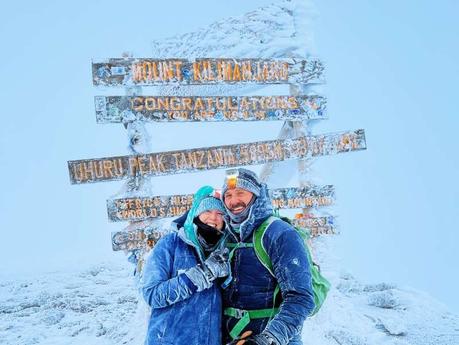
It's summit day. It's midnight and despite the howling winds we're leaving Barafu Camp, or Base Camp (4673m / 15331 ft) to the summit of Kili (5895m / 19,341 ft).
And this is the part that's hard to write - the reason I took so long to post about Kili. I get anxious and feel my heart tighten, with tears coming to my eyes as I write this, but here goes...
I'm anxious, but remind myself to breath and just go Pole Pole, slowly, slowly as our guides have reminded us multiple times a day.
The howling wind at 80km/hour (50 mph), makes it even harder to breathe. I keep up with the group. I've got this. I'm my own personal cheerleader.
We stop for a short rest (3-5 minutes) every 45-60 minutes, but as it's soooooo cold, we're taking shorter breaks than planned.
After a couple of hours or so, I mind myself trailing behind part of the group. A guide, Saheed stays with me. We slow the pace even more. Each breath is laboured, and difficult, but still I can do this. I knew it would be difficult.
Until... I can't breathe. It's not just difficult to breathe as expected with 50% less oxygen, I actually can't get any air into my lungs. I panic for a moment, then briefly tell myself that I know what I need to do. I need to go down.
Deciding to go down despite being only a couple of kms from the summit was one of the easiest choices I've ever made. When you can't breathe, nothing else matters. All that you care about is not dying in that moment. So I start to descend with the guide.
I need oxygen, but one oxygen tank is with the group ahead, the other is with the group below. We descend for 10 minutes or so before meeting the latter part of the group.
My guide Saheed asks if I still need oxygen, assuming that I don't now that we're descending. I still can't breathe, so I take the oxygen.
After taking oxygen for a few minutes, we carry on descending down the heavy scree. I still can't breathe, so I take more oxygen. We run into another group and I see the fear in their eyes as they see me on oxygen and Saheed exchanges worried words with the other guide.
We continue, until we reach Barfu Camp at around 4am. We have to kick the porter out of my tent, who was sleeping in my tent ensuring that nothing was stolen by the other groups. I feel terrible at the awful wakeup hour, but am feeling so bad there's no other option.
Saheed gives me more oxygen, then measures my oxygen and heart rate. If my vitals aren't within the normal range, we'll have to continue descending despite the wind, despite the cold.
While they're not great, fortunately, they're good enough that I can sleep for a couple of hours before descending. It seems to take a long time before I can sleep.
After quickly eating something, Saheed sends a porter with me to start descending. I can breathe better but still feel like I'm gasping for air and am disoriented and dizzy.
And that's why, instead of a photo of me on the summit, there's one of @catcoq and @adampalmeter who did make it to the summit.
Unfortunately, due to the awful weather, they didn't get the epic sunrise that Kili is famous for.
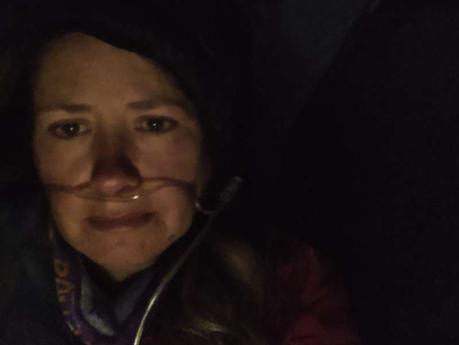
The photo of me is in my tent at Barafu Camp on oxygen for the third time. Saheed was kindly stroking my head - a very kind comforting gesture considering I hadn't washed my hair in 7 days, and I didn't even want to touch my hair.
I don't have any photos of the summit ascent, as it was dark, so the photos are from the descent from Barafu Camp.
Walking Distance: 10.6 mi/17.0 km
Walking Time: 13-16 Hours
Elevation Gain: 4,045 ft/1,233 m
Elevation Loss: 9,345 ft/2,848 m
+ another 3 hours to Mweka Gate, which was supposed to be Day 8.
Day 8: Mweka Camp to Mweka Park Gate to Hotel
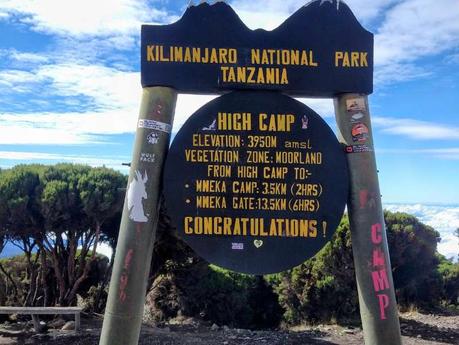
After summiting, or in my case attempting to summit, the plan was to sleep for a couple of hours, eat something, then descend via the Mweka route down to Mweka Camp and spend the night there.
Then, the next day (Day 8, it's just a 3 hour walk down the Mweka trail to Mweka Gate. The idea is that you're soooo tired by then, you need an easy day to recover.
But at this point I just wanted to be done and at a lower elevation so that it would be easier to breath, so I descended all the way to Mweka Gate, turning an 8-day trip into a 7 day one, as did the rest of my group coincidentally.
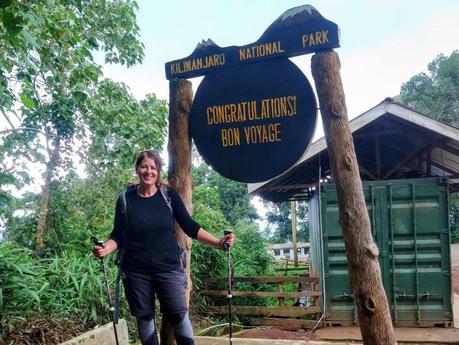
While this is a LONG day, especially if you summited, it's amazing to hike through four different climate zones in a day. I also

Back at the hotel, I'm feeling better, but am still disoriented. I also see that my memory is terrible. I'm struggling to remember words. I'm told this is normal after a lack of oxygen. However, in my case it lasts a few weeks with me forgetting names, which leg I stretched and so on.
Aftermath of My Failed Kilimanjaro Summit Attempt
Back home a few days later, friends ask me how Kili was. I can't talk about it. Only now over a month later I can, but it's still emotional.
Not being able to breathe was the scariest moment I've ever had on a mountain. While of course, I'm disappointed that I didn't summit, in that moment nothing else mattered except for being able to get even a tiny bit of oxygen into my lungs.
I try and go for an easy hike back at home in the Pirin Mountains of Bulgaria, but panic.
A couple of weeks after that, I'm caught in a small avalanche while winter hiking. The mountains, once my happy place, have turned scary.
I turn to meditation, calming breathwork and emotional freedom technique (EFT, better known as tapping). This all helps, but I'm still processing everything.
Health-wise, I've consulted with a couple of doctors and need extensive tests on my heart and lungs. They have a few ideas of what caused me to not be able to breathe but I won't get into that for privacy and insurance reasons.
I exercise and hike regularly (I just completed my #104MountainDays Challenge), and was also mentally prepared, had all the right gear for Kili, positive attitude and while I didn't summit, I think preparation, both physical and mental, is key to not only summiting, but actually having an enjoyable trip, as is having the right information - ie, not doing it in November when I did when it rained SOOOO much.
I also can't overstate the important of booking your Kilimanjaro trek with a reputable company. Unlike, Everest Base Camp, you can't do Kili on your own. You have to go with a guide. And this is NOT the time to cheap out.
I was beyond grateful for the experienced guide who got me safely off of Kili in what could have turned out to be a very different situation had there not been a guide available to go down with me.
Or if I'd gone with a company that only had 1 bottle of oxygen that had to go with the lead guide. Or if I'd had to descend with a guide that wasn't as experienced and didn't recognize the severity of my situation.
If you find yourself unable to breathe, or run into a critical emergency, trust me, you'll want to be with a very experienced guides and multiple guides - in case you, or someone else in your group has to turn around.
That's why I partnered with Pajoma Safaris. They include base gratuities in the guides, porters and other staff salaries, so they're able to make a fair living wage, which attracts the best of the best. And when it comes to guides, you definitely want the best of the best! You can see our Kilimanjaro tour here.
See this post on Facebook, or See this post on Instagram.
Lemosho Route 8 Days
Based on my conversations with different guides, porters and research, I think the Lemosho Route 8 Days, is the best route, and for the reasons mentioned at the beginning of the article.
Alternatively, you can also do it in 7 days if you don't mind a long steep descent on the last day. But you need to be forewarned, that it's a LONG day, and if you have knee issues, I don't remcommend it, since it's a LONG STEEP descent.

